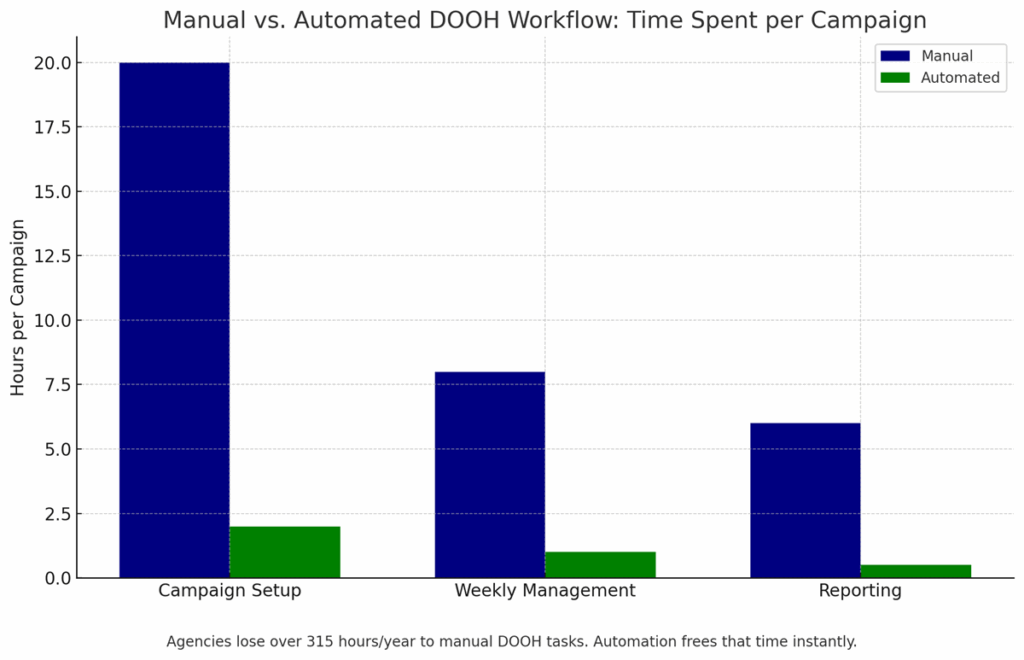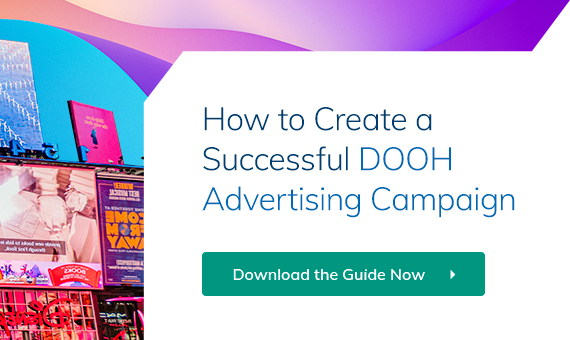For marketing agencies ready to scale beyond manual workflows
Picture this. It’s 4 pm on Friday. Your client needs their DOOH campaign live on Monday morning across 15 cities and you’re still waiting for rate cards from three different vendors.
Meanwhile, you have five different creative formats to produce, each requiring manual resizing for dozens of screen specifications.
Sound familiar?
This scenario plays out daily for agencies trying to leverage Digital Out of Home advertising. While DOOH offers unmatched reach and impact, the operational reality has remained frustratingly manual – until now.
Automation is fundamentally changing how agencies approach DOOH campaign management, transforming what used to take weeks into workflows that complete in minutes.
The result?
Faster launches, better performance, and teams that can focus on strategy instead of spreadsheet management.
The True cost of manual DOOH workflows
But before diving into solutions, let’s quantify what manual processes cost agencies. A typical multi market DOOH campaign involves:
Planning Phase. 8-12 hours sourcing inventory from multiple vendors, comparing rates and negotiating terms across different platforms and pricing models.
Creative Production. 15 20 hours reformatting assets for various screen specifications, creating multiple versions, and managing approval cycles for each variation.
Campaign Management. 5 – 8 hours weekly, monitoring performance across disconnected dashboards, manually adjusting schedules and consolidating reports from different sources.
Reporting. 4 – 6 hours per campaign, creating client presentations by aggregating data from multiple vendor platforms.
For a mid-size agency running x10 DOOH campaigns quarterly, this represents over 400 hours annually, equivalent to hiring an additional team member just to handle administrative tasks.
But the hidden costs run deeper. Manual workflows create bottlenecks that delay campaign launches, increase error risk and limit your ability to respond quickly to client needs or market opportunities.
In competitive pitch situations, these operational limitations can mean the difference between winning and losing new business.

Stop chasing vendors. Automated inventory access
Traditional DOOH buying meant navigating a fragmented landscape. Roadside advertising required one vendor relationship, transit another, retail environments a third. Each had different platforms, timelines and reporting standards.
Automated inventory platforms consolidate this complexity into unified workflows. Platforms like The Neuron provide access to over 1.7 million screens globally through a single interface, transforming DOOH buying from vendor management into programmatic activation.
Here’s what this means practically:
Instant Inventory Browsing. Instead of waiting days for availability confirmations, agencies can view real time inventory across multiple environments, retail, transit, roadside and digital billboards, filtering by location, audience demographics and screen specifications.
Unified Booking Process. One contract, one insertion order and one point of contact for campaigns spanning multiple markets and media types.
Transparent Pricing. Real time rate cards eliminate negotiation delays and pricing uncertainty.
This consolidation doesn’t just save time, it enables agencies to scale DOOH operations without proportionally scaling headcount.
Whether planning a local restaurant promotion or a national brand campaign across 50+ markets, the platform complexity remains constant.
Dynamic creative. From production bottleneck to performance advantage
Creative production has traditionally been DOOH’s biggest operational challenge. Static assets don’t adapt well across different screen ratios, locations, or real time conditions. Agencies often found themselves creating dozens of variations for a single campaign, each requiring separate approval cycles.
Automated creative platforms solve this through dynamic templates and smart rendering systems that adapt assets in real time based on contextual triggers.
Smart Resizing. Creative automatically adjusts to any screen specification from vertical transit displays to horizontal highway billboards without manual intervention or quality loss.
Contextual Adaptation. The same creative template can display different messages based on weather conditions, time of day, local events, or traffic patterns. A coffee chain’s campaign might show iced drinks when temperatures exceed 20°C and hot beverages when it drops below 10°C.
Centralized Approval Workflows. Clients review and approve dynamic templates once, rather than individual static variations, reducing approval cycles from weeks to hours.
The performance impact is measurable. According to the Digital Place-based Advertising Association (DPAA), dynamic creative in DOOH campaigns delivers up to 32% higher ad recall compared to static equivalents.
For agencies, this transforms creative from a logistical challenge into a competitive advantage.
Consider this real world example. A national retail chain used dynamic creative to promote different products based on local weather and inventory levels.
Instead of running generic promotions, stores in rainy markets automatically displayed umbrella ads while sunny locations promoted sunglasses. The result was 47% higher foot traffic compared to their previous static campaigns.
Contextual intelligence. When and where campaigns perform best
Traditional DOOH scheduling relied on fixed time blocks and broad demographic assumptions. Automated platforms enable rule based triggering that makes campaigns contextually intelligent.
Weather Based Activation. Ads trigger automatically based on real time weather conditions.
Traffic Responsive Frequency. Campaign intensity automatically adjusts based on traffic patterns and congestion levels, ensuring optimal exposure during peak visibility windows.
Event Driven Messaging. Campaigns can adapt to local events, sports results, or breaking news, maintaining relevance without manual intervention.
Time Sensitive Offers. Restaurants can automatically promote lunch specials during morning commute hours and happy hour deals during evening rush periods.
According to eMarketer research, 67% of advertisers report that contextually triggered DOOH campaigns outperform standard scheduled placements in both engagement metrics and conversion rates.
This contextual intelligence doesn’t just improve performance, it maximizes budget efficiency by reducing wasted impressions during irrelevant moments.
Transparent performance. From estimates to verified results
DOOH measurement has historically relied on foot traffic projections and demographic estimates, making ROI calculations challenging and client conversations difficult.
Automated reporting platforms now provide verified, real time performance data that rivals digital advertising in granularity and accuracy.
Verified Impressions. Third party measurement technologies provide actual viewer counts rather than traffic estimates, giving agencies concrete delivery numbers.
Attribution Tracking. Integration with mobile data and point of sale systems enables measurement of real world outcomes such as store visits, app downloads and purchase behavior.
Automated Reporting. Client-ready reports generate automatically, combining performance data across all screens, markets and campaign elements into unified dashboards.
Cross Platform Comparison. Standardized metrics enable direct performance comparison between DOOH and other media channels, supporting integrated campaign planning.
Research indicates that automated DOOH attribution reduces reporting preparation time by over 50%, while improving accuracy and client confidence in campaign results.
For agencies, this transparency transforms client relationships. Instead of defending estimated reach numbers, you’re presenting verified performance data that demonstrates clear value and supports budget increases.
Addressing common implementation concerns
“Our team isn’t technical enough for automation platforms”
Modern DOOH automation platforms are designed for marketing professionals, not developers. Most agencies see team members confidently using new systems within 2 – 3 days of training.
“Automation costs more than our current manual processes”
While platform fees exist, most agencies see positive ROI within 60 – 90 days through time savings and improved campaign performance. The alternative cost of hiring additional staff to handle manual processes often exceeds automation investment.
“We’ll lose control over campaign details”
Automation enhances control rather than reducing it. Real time dashboards and automated alerts provide more visibility into campaign performance than manual processes ever could.
“Integration with our existing workflow seems complex”
Leading platforms offer API connections and workflow integration that complement, rather than replace, existing agency tools and processes.
ROI framework. Calculating your automation advantage
Here’s a simplified framework for evaluating automation ROI:
Time Savings Calculation:
- Manual campaign setup: 20 hours → Automated: 2 hours = 18 hours saved
- Weekly management: 8 hours → Automated: 1 hour = 7 hours saved weekly
- Reporting: 6 hours → Automated: 30 minutes = 5.5 hours saved per campaign
For 10 campaigns annually, 315+ hours saved = equivalent to 8 weeks of full time work.
Performance Improvements:
- Average campaign performance increases by 15 – 25%
- Client retention improvement from better service delivery
- New business wins from faster response times and competitive capabilities
Getting Started Small: Most agencies begin automation with single market campaigns or specific clients, gradually expanding as comfort and results build. This approach minimizes risk while demonstrating value.
Your competitive advantage through speed, scale and client success
Automation doesn’t just improve operational efficiency, it fundamentally changes what agencies can offer clients and how quickly they can deliver.
Faster Client Response. Respond to RFPs with detailed DOOH proposals in hours instead of days, including specific inventory recommendations and creative concepts.
Expanded Service Capabilities. Handle larger, more complex campaigns without proportional staff increases, enabling growth without margin pressure.
Improved Client Outcomes. Deliver measurably better campaign performance through contextual targeting and dynamic creative optimization.
Enhanced Client Relationships. Provide transparent, real time performance reporting that builds trust and supports budget expansion conversations.
For agencies evaluating DOOH automation, the question isn’t whether to adopt these capabilities, it’s how quickly you can implement them before competitors gain the same advantages.
Ready to transform your DOOH operations?
DOOH automation represents more than operational improvements. It’s a strategic capability that enables agencies to deliver better results, serve clients more effectively and scale operations profitably.
Whether you’re handling your first DOOH campaign or managing dozens annually, automation provides the foundation for sustainable growth in this rapidly expanding channel.
See automation in action. Book a personalized demo to explore how The Neuron can streamline your DOOH workflow from planning to reporting and discover why leading agencies are choosing The Neuron’s automation to stay competitive in the evolving media landscape.


